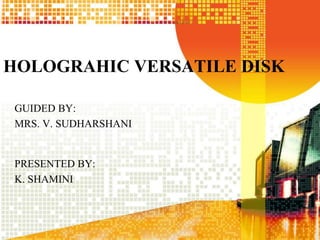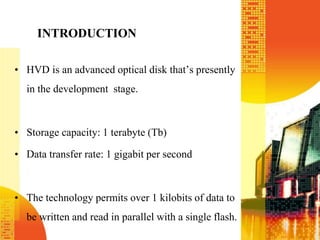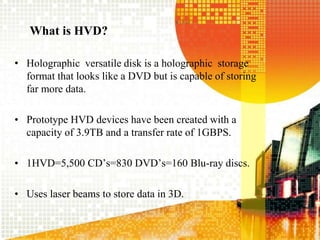Holographic versatile disk
- 1. HOLOGRAHIC VERSATILE DISK GUIDED BY: MRS. V. SUDHARSHANI PRESENTED BY: K. SHAMINI
- 2. CONTENTS: ŌĆó Introduction ŌĆó Need of HVD ŌĆó What is HVD? ŌĆó Basics of holographic memory ŌĆó Technology used in HVD ŌĆó Structure of HVD? ŌĆó Writing data ŌĆó Reading data ŌĆó Advantages, disadvantages and applications of HVD ŌĆó Facts ŌĆó Future aspects ŌĆó conclusion
- 3. INTRODUCTION ŌĆó HVD is an advanced optical disk thatŌĆÖs presently in the development stage. ŌĆó Storage capacity: 1 terabyte (Tb) ŌĆó Data transfer rate: 1 gigabit per second ŌĆó The technology permits over 1 kilobits of data to be written and read in parallel with a single flash.
- 6. Types of optical storage Capacity Writing/ Reading Speed Discs Approx. Cost Recordable Player Approx. Cost Holographic Versatile Discs (HDSS) HVD 300 GBŌĆō 1.6 TB 1 GB/s $120 $3000 Blu-ray Discs BD 25 GBŌĆō 50 GB 36.5 Mb/s $18 $2000 Digital Versatile Discs DVDŌĆō HD- 5 GBŌĆō 30 GB 36.5 Mb/s $10 $2000 Compact Discs CD 783 MBŌĆō 1.3 GB 36.5 Mb/s $4 $200
- 7. What is HVD? ŌĆó Holographic versatile disk is a holographic storage format that looks like a DVD but is capable of storing far more data. ŌĆó Prototype HVD devices have been created with a capacity of 3.9TB and a transfer rate of 1GBPS. ŌĆó 1HVD=5,500 CDŌĆÖs=830 DVDŌĆÖs=160 Blu-ray discs. ŌĆó Uses laser beams to store data in 3D.
- 8. Basics of holographic memory ŌĆó Holography is a method of recording patterns of light to produce a 3D object . ŌĆó Recorded patterns of light is called a hologram. ŌĆó Creation of a hologram begins with a focused beam of light, a laser. ŌĆó Laser splits up into two beams: 1. Reference beam 2. Information beam ŌĆó When light encounters an image its composition changes.
- 9. ŌĆó When the information beam encounters an image, it carries that image in its waveforms ŌĆóWhen the two beams intersect, it creates a pattern of light interference and that can be recorded on the photosensitive polymer layer of the disk. ŌĆó To retrieve the information stored in a hologram, shine the reference beam onto the hologram. When it reflects off the hologram, it holds the image pattern of the stored image. ŌĆó This reconstruction beam is then sent to a CMOS sensor to recreate the original image.
- 10. Technology used in HVD ŌĆó Collinear holography- the laser beams are collimated. ŌĆó Blue-green laser reads the data encoded in the form of laser interference. ŌĆó Red laser serves the purpose of reference beam and to read servo info. ŌĆó A layer of dichroic mirrors, between the holographic and servo data layer reflects the blue-green laser beam, letting only the red laser to pass through it to reach the servo information .
- 11. ŌĆó The concepts of collinear holographic memories are: ŌĆó To increase the recording capacity, thick volume-recording media is used. ŌĆó Optical disk is pre-formatted with addresses and optical servo information. ŌĆó The beam for the optical servo is utilized to provide backward compatibility with d existing CDŌĆÖs and DVDŌĆÖs.
- 13. Structure of HVD The holographic versatile disk structure consists of the following components: ŌĆó Green writing/reading laser (532nm) ŌĆó Red position/addressing laser (650nm) ŌĆó Hologram (data) ŌĆó Polycarbon layer ŌĆó Photo polymeric layer (data-containing layer) ŌĆó Distance layers
- 14. ŌĆó Dichroic layer (reflecting green light) ŌĆó Aluminum reflective layer (reflecting red light) ŌĆó Transparent base
- 15. Writing Data ŌĆó a simplified HVD system consists of the following main components: ŌĆó Blue or green laser (532nm wavelength) ŌĆó Beam splitter/merger ŌĆó Mirrors ŌĆó Spatial light module (SLM) ŌĆó CMOS sensor ŌĆó Photopolymer recording medium
- 16. Information is encoded into binary and is stored in the SLM. These data are turned into ones and zeros represented as opaque or translucent areas on a ŌĆśpageŌĆÖ. When the information beam passes through the SLM, portions of the light are blocked by the opaque areas of the page, and portions pass through the translucent areas. When the reference beam and the information beam rejoin on the same axis, they create a pattern of light interference, the holography data. This interference pattern is stored in the photopolymer area of the disc as a hologram.
- 18. Reading Data: ŌĆó To read, we have to retrieve the light pattern stored in the hologram ŌĆó Laser is projected onto the hologram ŌĆōa light beam that is identical to the reference beam. ŌĆó The hologram diffracts this beam according to the specific pattern of light interference is storing. ŌĆó The resulting light recreates the image of the page that established the light-interference pattern-reconstruction beam.
- 19. ŌĆóThe CMOS sensor then reproduces the page data. ŌĆóThe reconstruction beam-bounces back off the disc, it travels to the CMOS sensor.
- 20. Advantages, Disadvantages And Applications ŌĆó Advantages: ŌĆó More storage capacity ŌĆó Data transfer date is high ŌĆó Disadvantages: ŌĆó Initial price of the player and disk are high ŌĆó Price and data storage not confirmed still in R & D ŌĆó Applications: ŌĆó Used for storing large amounts of data most likely for large companies ŌĆó Could be the most efficient way to back up information in the near future.
- 21. Facts ŌĆó The entire US library of congress can be stored on six HVDŌĆÖs, assuming that every book has been scanned in the text format. The library of congress is the largest in the world and contains over 130 million items. ŌĆó The pictures of every landmass of earth-like the one shown in the Google earth can be stored on two HVDŌĆÖs.
- 22. Future Aspects ŌĆó Have tremendous implications in the commercial, industrial and d-cinema realms. ŌĆó Will find wide use for backing up and archiving the media libraries, including the one at the Hollywood studios.
- 23. Conclusion ŌĆó The HDVŌĆÖs will soon replace DVDs and blu-ray disks. ŌĆó Currently supported by more than 170 of the worlds leading consumer electronics, personal computer, recording media, video game and music company. ŌĆó The format has also broad support from the major movie studios as a successor to today's DVD and blu-ray disk format.
























